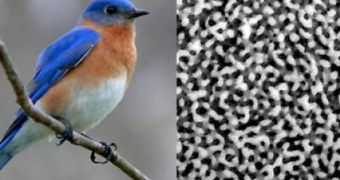Almost all things that are colored in nature, from ourselves to the beautiful feathers of some birds, get their hues from pigments, which are produced by the skin, scales, hair, or whatever is covering the respective creature. However, some birds get their coloring from tiny, nano-scale structures that resemble beer foam in appearance. Their internal make-up is similar to that of an incredibly small sponge, but the hues they generate are unbelievably beautiful.
The new research, published online in the journal Soft Matter, has been conducted by investigators at the Yale University and has focused on the feathers of birds such as Bluebirds and Blue Jays. The researchers say that when they have magnified the colored feathers under the electron microscope, they have noticed that the structures that are responsible for the color resemble tiny sponges filled with air bubbles.
Surprisingly enough, the method in which feathers grow and get to have their colors is very similar to the processes going on inside a bottle of carbonated drink, when the cap is pulled off. A stage known as phase separation occurs, when compounds become instable and begin to “boil,” which releases the carbon dioxide from the water. The same thing happens inside bird feathers, only on a much smaller scale. The color-producing structures grow inside a protein-rich “soup” inside the small feather, but, as the latter grows, it moves to the surface, and molecules of air start permeating the mixture.
“Many biologists think that plumage color can encode information about quality – basically, that a bluer male is a better mate. Such information would have to be encoded in the feather as the bubbles grow. I think our hypothesis that phase separation is involved provides less opportunity for encoding information about quality than most biologists thought. At the same time, it's exciting to think about other ways birds might be using phase separation,” one of the authors of the new study, the Chair of the Department of Ecology and Evolutionary Biology, Richard Prum, explains.

 14 DAY TRIAL //
14 DAY TRIAL //